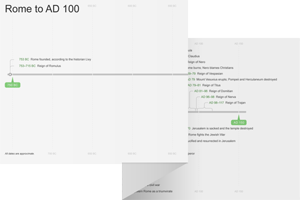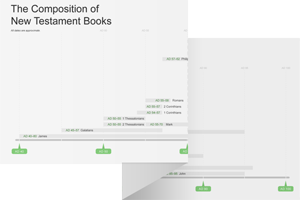1:1–8 In the prologue, the book of Revelation |
 Understanding John’s Revelation
Understanding John’s Revelation
1:1 The revelation of Jesus Christ This revelation may be understood as being “of” Jesus or “from” Jesus. This phrase may mean that Jesus is the content of the revelation or that He is the revealer of the hidden realities being disclosed in this book. The title “Jesus Christ”—or “Jesus the Messiah” —occurs only in the first five verses, but nowhere else in the book.
—occurs only in the first five verses, but nowhere else in the book.
slaves The Greek word doulos can be translated as “slave” or “servant.” However, the translation “slave” is fitting because it describes a person’s total commitment and devotion to Jesus or another such person or thing (i.e., “slaves to sin”).
is fitting because it describes a person’s total commitment and devotion to Jesus or another such person or thing (i.e., “slaves to sin”).
take place in a short time The events of the book are spoken of as imminent (vv. 3; 22:10). New Testament writers often speak of end-time events as beginning in their own days (e.g., Rom 16:20; Heb 1:2; 1 Pet 4:7). God’s final victory over evil and the establishment of His kingdom will be completed in the future, but they have also been brought into the present through the death and resurrection of Jesus.
1:3 Blessed is The first of seven beatitudes in Revelation (Rev 14:13; 16:15; 19:9; 20:6; 22:7, 14), reminiscent of Jesus’ Sermon on the Mount (Matt 5:3–11).
those who hear Many people in the first century were illiterate and received instruction by having it read to them.
observe The blessing is brought about through obedience and adherence to the revelation.
1:4 seven churches in Asia While these seven churches were not the only ones in Asia (a western region of modern-day Turkey), they were influential and located on a well-known circular route. The number seven often denotes fullness or completion in the Old Testament (e.g., Gen 2:2; Lev 26:18; Josh 6:4). John uses the number in this way throughout Revelation—most notably in the judgment sequences (seven bowls, seven trumpets). The seven churches would have been understood as representing all the churches of Asia, and perhaps the entire worldwide Church.
were not the only ones in Asia (a western region of modern-day Turkey), they were influential and located on a well-known circular route. The number seven often denotes fullness or completion in the Old Testament (e.g., Gen 2:2; Lev 26:18; Josh 6:4). John uses the number in this way throughout Revelation—most notably in the judgment sequences (seven bowls, seven trumpets). The seven churches would have been understood as representing all the churches of Asia, and perhaps the entire worldwide Church.
seven spirits Possibly alludes to the sevenfold spirit of God in Isa 11:2. The number seven indicates the fullness of the Holy Spirit’s work (compare Rev 3:1; 4:5; 5:6).
1:5 faithful witness Refers to Jesus, who testified faithfully unto death (compare John 1:18; 18:37; 1 Tim 6:13).
firstborn from the dead Describes the inaugurator of resurrection life. See note on Col 1:15.
ruler of the kings of the earth Reminiscent of Dan 2:47 (see Rev 17:14; 19:16).
by his blood Jesus freed us from our sins through the shedding of His blood at the crucifixion (see note on Heb 9:7 and note on Heb 9:22; compare Isa 53:10–12).
freed us from our sins through the shedding of His blood at the crucifixion (see note on Heb 9:7 and note on Heb 9:22; compare Isa 53:10–12).
1:6 kingdom, priests In Christ, God has done for the Church what He had earlier done for Israel (compare Rev 5:10; 1 Pet 2:9; Exod 19:5–6).
Amen The Greek word used here, meaning “let it be so,” served to strongly affirm something just stated. It expressed an indication of trust in God’s ability to bring about a desired result.
1:7 he is coming with the clouds John applies the imagery of the son of man from Dan 7:13–14 to Jesus. Cloud imagery also recalls the manner in which Jesus left the earth (Acts 1:9).
every one who pierced him An allusion to Zech 12:10.
1:8 the Alpha and the Omega The first and last letters of the Greek alphabet. The expression is a merism—a figure of speech that distinguishes opposites in order to accentuate the whole. God is the beginning and the end and everything in between.
the All-Powerful God’s power will be demonstrated in this book.
1:9–20 John describes here the circumstances of his receiving the revelation, drawing on imagery from the book of Daniel to describe the glorified Christ. John then receives the commission to write to the seven churches. |
1:9 your brother A common term of endearment among first-century believers, highlighting their equality in Christ. The common barriers of status, gender, and rank were done away with in the early church, and a sense of familial obligation predominated.
co-sharer Persecution is a persistent theme of Revelation. John identifies with those undergoing persecution because he likewise endures hardship for the cause of Christ.
the affliction and kingdom The language suggests that the believers to whom John is writing are suffering persecution (or tribulation) and that the kingdom is, through the power of the Spirit’s work in their lives and the world, already present with the Church.
Patmos A small, rocky island in the Aegean Sea. Patmos may have been used as a Roman penal colony.
may have been used as a Roman penal colony.
word of God Church tradition indicates that John was banished to Patmos to hinder the growth of the Church.
1:10 in the Spirit Probably describes a visionary state (compare Acts 10:10; 2 Cor 12:2–4). John’s visions are framed by his four experiences in the Spirit (Rev 1:10; 4:2; 17:3; 21:10).
the Lord’s day Sunday, on which believers celebrate Christ’s resurrection from the dead.
on which believers celebrate Christ’s resurrection from the dead.
great sound The voice of the glorified, exalted Christ.
1:12 I turned to see the voice John received the command to write and looked around to see who issued it.
seven gold lampstands Golden lampstands stood in the Holy Place of the tabernacle and the temple (Exod 25:31–37; 1 Kgs 7:49). Zechariah also had a vision of a golden lampstand (Zech 4:2). The significance of these lampstands is explained in Rev 1:20.
1:13 midst of the lampstands Christ is present among His Church.
one like a son of man John draws on the vision of the Ancient of Days in Dan 7 and the vision of the angelic figure in Dan 10 in the following verses (see Dan 7:9; 10:5). During His ministry, Jesus used Daniel’s son of man terminology in reference to Himself (e.g., Matt 9:6; 10:23; 11:19).
dressed in a robe reaching to the feet Perhaps indicative of the high priestly garments in Exod 28 (compare Dan 10:5).
with a golden belt The figure in Dan 10:5 also had a golden belt.
1:14 white like wool In Dan 7:9, the Ancient of Days’ clothing is white like snow and the hair of His head is compared to pure wool. John combines the two descriptions to describe the head and hair of Christ.
his eyes were like a fiery flame In Dan 10:6, the eyes of the angelic figure are compared to flaming torches. In Daniel 7:9, the throne of the Ancient of Days is compared to fire.
1:15 when it has been fired in a furnace See Dan 10:6. In Daniel 7:9, the wheels on the throne of the Ancient of Days “were burning fire.”
like the sound of many waters This is similar to Dan 10:6, where the angelic voice is likened to the sound of a multitude (compare Ezek 1:24; 43:2). Revelation 1:10 ascribes trumpet-like characteristics to Christ’s voice. The emphasis is on the force and authority with which He speaks.
1:16 his right hand Represents strength and special blessing.
sharp double-edged sword May indicate the power of His words—the words of the Word of God (see John 1:1–5; compare Rev 2:16; 19:15, 21).
like the sun shining in its strength In Daniel 10:6, the face of the angelic figure is “like lightning.” This description also reflects the transfiguration in Matt 17:2.
1:17 like a dead person Falling to the ground from reverence and fear is a common reaction to encounters with the divine.
Do not be afraid A common heavenly greeting to people (e.g., Gen 15:1; Dan 10:12; Luke 1:30).
1:18 the one who lives Jesus conquered death through the resurrection.
keys of death and of Hades Keys represent authority. Christ has the authority both to confine and release from death (see John 5:25–29; compare Matt 16:19). See note on Rev 6:8.
1:19 write This verse is often viewed as an outline of the book: It contains what John saw (ch. 1), what is (chs. 2–3), and what will take place later (chs. 4–22). However, since there are elements of past, present, and future mixed throughout the book, it is best to take this verse as a directive to John to write down the entire contents of his vision—both present and future (compare ch. 12).
 Four Views of Revelation Table
Four Views of Revelation Table
1:20 the angels of the seven churches Could refer to angelic beings or human leaders.
 New Testament Terms for Unseen Divine Beings
New Testament Terms for Unseen Divine Beings
 Angels in the Bible Table
Angels in the Bible Table

|
About Faithlife Study BibleFaithlife Study Bible (FSB) is your guide to the ancient world of the Old and New Testaments, with study notes and articles that draw from a wide range of academic research. FSB helps you learn how to think about interpretation methods and issues so that you can gain a deeper understanding of the text. |
| Copyright |
Copyright 2012 Logos Bible Software. |
| Support Info | fsb |
 Loading…
Loading…




